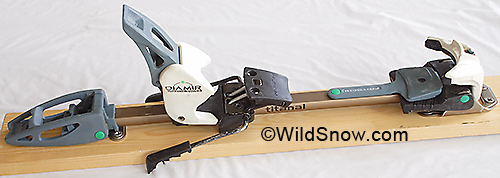Latest addition to our Online Museum of Backcountry Skiing is the Fritschi Diamir Titanal binding. First sold around 1995, the Diamir is arguably the first “modern” randonnee binding that approached the downhill performance of its contemporary alpine bindings. This design is the foundation of what’s become quite the amazing string of binding models from Fritschi, all based on the original design first seen in the Titanal. Museum display here.

Complete Fritschi Diamir Titanal binding. The design revolution with this binding was in using a single lightweight rail to connect heel and toe units. This rail was ostensibly made from Titanal, a very strong aluminum alloy. Nonetheless the rail bent too easily and was strengthened in later models. In all, the binding was very lightweight and had a modern look and feel.
While the first Diamir Titanal was revolutionary and effective, it was not without sometimes amusing problems. When the earliest production model first arrived here at WildSnow HQ, we headed out to the shop for mounting and bench testing. About the third time we switched the heel to boot-latched mode, it flew apart in a cloud of high-speed shrapnel that could have taken out an eye. Black Diamond was distributing the binding (as they still do), and the ensuing scramble to get stronger heel units out and keep me quiet was amusing to behold. To BD’s credit, the defective plastic was immediately swapped out for all bindings, and didn’t become a big problem in the consumer realm.
Another ongoing and eventually amusing issue with the Titanal and several models that followed was that the boot heel sat slightly lower or at least level with the toe. Compared to most other randonee and alpine bindings, this created what’s known as “negative ramp angle” which made many users of the binding feel like they were in the “back seat” while skiing. Experienced skiers figured this out right away and implemented various solutions such as shimming the rear of the binding higher or grinding rubber of the toe of the boot. Nonetheless, I wish I had a dollar for every email or phone question I’ve had over the past decade asking me “why do I feel like I’m in the backseat when I ski on my Fritschis?”

Diamir, thumbnail.
Ramp angle is not an issue with latest model Fritschi bindings (they all put your foot in good position), but the lessons learned from this can be applied to any ski setup. Some bindings have more ramp, some less, and the amount affects the way they ski.
In all, the Fritschi bindings helped create a revolution in skiing, that being the resurgence of muscle power as an honorable if not sexy way of getting your turns. Proof: It’s now considered high style at the resort to sport a pair of Fritschi bindings — even if you’re riding ski lifts.
WildSnow.com publisher emeritus and founder Lou (Louis Dawson) has a 50+ years career in climbing, backcountry skiing and ski mountaineering. He was the first person in history to ski down all 54 Colorado 14,000-foot peaks, has authored numerous books about about backcountry skiing, and has skied from the summit of Denali in Alaska, North America’s highest mountain.
